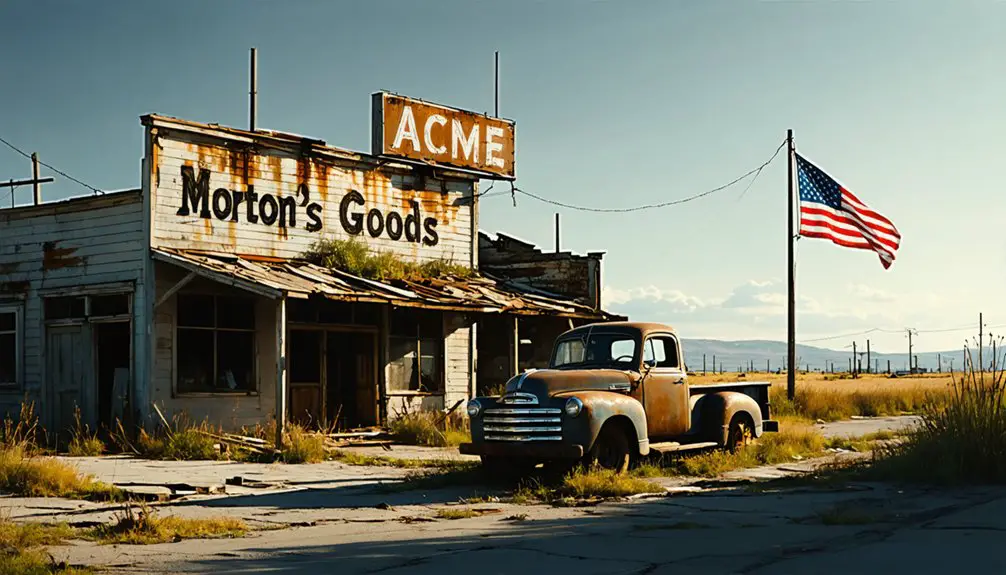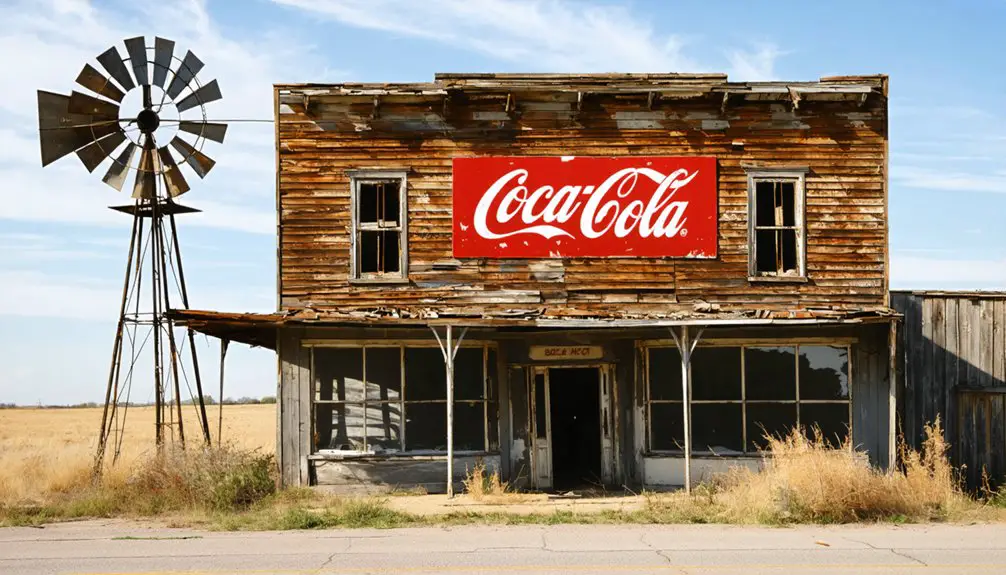You’ll find Acme’s ruins four miles northwest of Apache, Oklahoma, where a bustling gypsum mining town once thrived. Founded in 1911, it supported 100-125 workers who produced eight freight carloads of plaster daily via the Chicago Rock Island Railroad. The Great Depression and devastating floods of 1926-1927 triggered the town’s decline, leading to the mill’s closure and mass exodus. Today’s scattered concrete foundations and weathered structures tell a deeper story of Oklahoma’s industrial past.
Key Takeaways
- Founded in 1911 as a gypsum mining company town, Acme thrived with a dedicated railroad spur and cement plant operations.
- At its peak, 100-125 workers operated the gypsum plant, with the town featuring a general store, post office, and schoolhouse.
- The Great Depression in 1930 forced the gypsum mill’s permanent closure, causing workers to dismantle operations and leave town.
- Severe flooding in 1926-1927 damaged gypsum beds, while the Dust Bowl and economic hardship accelerated the town’s abandonment.
- Today, Acme is a ghost town with only concrete foundations and ruins remaining, overtaken by vegetation and rural landscape.
Early Industrial Foundations and Mining Operations
When Oklahoma achieved statehood in 1907, the town of Acme emerged shortly after as a promising industrial center, founded in 1911 around the operations of the Acme Cement and Plaster Company.
You’ll find that mineral extraction defined the town’s early identity, with gypsum mining driving economic sustainability through the company’s mill and power plant operations. The area later became known for its extensive lead-zinc deposits that would be developed into the Acme Mine.
The town’s industrial success led to the construction of a dedicated Chicago Rock Island spur, connecting the plant to major transportation networks.
Life in the Company Town
During peak production periods, you’d find 100-125 men operating heavy machinery and managing teams of horses at Acme’s gypsum plant, working shifts to produce up to eight freight carloads every 24 hours.
The company provided stratified housing options, including dedicated homes for supervisors, two boarding houses for single workers, and scattered dwellings throughout the town. The Fort Worth and Denver railway provided essential transportation services for the community. The town emerged in 1911 when the Acme Cement company established operations.
You could access daily necessities at the general store, send mail at the post office, and participate in community activities at the brick schoolhouse and gymnasium, though poor road conditions meant most workers needed to live within walking distance of the plant.
Daily Work and Living
Life in the industrial town of Acme, Oklahoma revolved around its bustling cement and plaster mill, where approximately 100-125 men worked continuously to produce up to eight freight carloads of plaster daily.
You’d find a clear labor structure, with plant superintendents and team bosses overseeing the demanding work schedules.
If you’d lived there, you’d have noticed the town’s practical layout centered on the mill. Single workers stayed in company boarding houses, while supervisors lived in company-provided homes.
Many workers built their own houses on leased land nearby due to poor roads. You’d have done your shopping at the general store across from the mill, which also housed the post office. The company’s focus on quality and reliability, which made it the largest brick manufacturer in America, was evident even in these early operations.
The Acme School began in a simple tent structure before moving to a permanent building, providing education for the workers’ children.
Thirty teams of horses and mules transported raw gypsum, while the Rock Island railroad hauled finished products to market.
Housing and Social Support
As a company town, Acme’s housing arrangements clearly reflected the social hierarchy of mill employment. You’d find management living in larger company-built homes near the plant, while most workers leased land and constructed their own modest dwellings nearby.
Worker accommodations included boarding houses for single men, creating tight-knit social networks among residents sharing similar experiences. The town’s community life was similar to that of Acme Brick Company, which had established its own company town named Bennett with homes, a church, and school.
The town’s social dynamics centered around key gathering spots. You could catch up on community news at the general store, which doubled as the post office.
Children attended the brick schoolhouse with its gymnasium, while adults found support through informal networks. The blacksmith shop, cotton gins, and railway depot served as additional hubs where residents maintained connections despite their remote location and demanding work conditions.
The Rock Island Railroad’s Role
When the Rock Island Railroad expanded into Oklahoma Territory in 1888, it transformed Acme’s industrial prospects by establishing essential transportation links throughout the region.
You’ll find the railroad’s impact was particularly significant when it built a dedicated spur line to serve the Acme Cement and Plaster plant, enabling the town’s gypsum industry to flourish.
The Choctaw, Oklahoma and Gulf acquisition in 1904 further strengthened the railroad’s network across the state.
At its height, you could see up to eight railcars of gypsum shipped daily, with 125 mill workers keeping production humming.
The railroad’s economic impact extended beyond just shipping – it connected Acme to critical markets and resources across Oklahoma Territory. Like its parent company that entered bankruptcy in 1933, the local rail service struggled during the Great Depression.
However, when gypsum deposits depleted and flooding damaged the plant in the late 1920s, the rail service’s decline signaled the beginning of Acme’s end.
Natural Disasters and Economic Challenges
Natural disasters struck a devastating blow to Acme’s fragile economy in the late 1920s, setting off a chain of events that would seal the town’s fate.
When heavy rains flooded the Little Washita River in 1926-1927, they buried vital gypsum beds under feet of sand, crippling the town’s mining operations. You’ll find this flood damage coincided with the depletion of original gypsum deposits, creating a perfect storm of resource scarcity.
The economic collapse that followed was swift and severe. As the Great Depression hit in 1930, the gypsum mill shut down permanently.
You’d have seen workers dismantling the mill’s massive machinery, tearing down buildings, and leaving town in search of jobs. The Acme Cement and Plaster Company had been the town’s primary employer and economic backbone since its founding.
Today, only concrete ruins remain where this once-bustling mining community stood.
The Town’s Gradual Disappearance

As you explore Acme’s decline after 1930, you’ll find the town’s physical structures rapidly deteriorated once the cement mill closed its doors.
The exodus began immediately after the shutdown, with workers and their families abandoning both company boarding houses and private homes near the factory site.
Today, you won’t see much more than scattered ruins along the old road corridor, as most buildings were either dismantled or left to decay in the decades following the town’s abandonment.
Physical Structures Fade Away
While the Acme Cement and Plaster plant once dominated the Oklahoma landscape with its imposing concrete structures and bustling industrial complex, time has steadily erased most traces of the town’s physical presence.
The industrial decay accelerated after the 1920s when gypsum deposits ran dry, leading to the plant’s closure by 1930.
You’ll find that nature’s forces – from floods to harsh weather – have taken their toll on the historical remnants.
The dismantling of large concrete buildings in the 1980s, along with the loss of supporting structures like stables, cotton gins, and the brick schoolhouse, has left little intact.
Today, you’ll discover only scattered concrete foundations and weathered ruins, with most of the site reclaimed by vegetation and the surrounding rural landscape.
Population Exodus After 1930
The Great Depression and Dust Bowl dealt devastating blows to Acme’s population in the 1930s, triggering an exodus that would permanently alter the town’s trajectory.
You’d have witnessed migration patterns similar to other Oklahoma towns, as farm incomes plummeted by 64% and tenant farmers, who made up over 60% of agricultural workers, faced widespread foreclosure.
The town’s community resilience was tested as the petroleum market collapsed and urban unemployment soared.
While some residents initially tried to weather the storm through charity efforts and makeshift settlements, Acme’s population decline mirrored the 15-18% drop seen across Oklahoma.
The sharp decrease in in-migration rates from 47.3% in the 1920s to just 15.5% in the 1930s, combined with environmental disasters and economic hardship, accelerated the town’s transformation into a ghost town.
Legacy and Remaining Structures
Today’s visitors to Acme, Oklahoma will find only scattered remnants of what was once a bustling industrial town.
While the historical significance of this ghost town preservation site lies in its role as a major gypsum producer, time has erased most traces of its industrial past.
The relentless march of time has steadily erased the industrial legacy of this once-thriving gypsum production center.
During Acme’s peak operations from 1911-1930, the town featured:
- A massive gypsum mill with industrial-scale machinery
- Two boarding houses serving the workforce
- A brick schoolhouse and gymnasium complex
- Essential services including a general store, post office, and blacksmith
The site exemplifies Oklahoma’s boom-and-bust resource towns of the early 20th century.
Though nature has reclaimed much of the area, surviving foundations and building remnants still hint at Acme’s former prosperity as a thriving mill town that once employed over 100 workers.
Frequently Asked Questions
Are There Any Paranormal Activities Reported in the Abandoned Structures?
You won’t find documented ghost sightings or haunted legends in these structures. Historical records and paranormal investigations reveal no reported supernatural activity, despite the town’s abandoned industrial buildings and empty homes.
Can Visitors Legally Explore the Remaining Ruins of Acme Today?
You’ll need landowner permission to legally explore the ruins, as exploration regulations indicate it’s likely private property. For visitor safety, unauthorized access isn’t recommended and could result in trespassing charges.
What Happened to the Mining Equipment After the Town’s Abandonment?
You’d find most mining equipment was dismantled or scrapped during the Great Depression. Like the massive mill machinery that once required buildings built around it – all recycled by the 1980s.
Were There Any Notable Crimes or Accidents During Acme’s Operational Years?
You won’t find recorded crime history or major accident reports during Acme’s operation. While mining and railroad work carried inherent risks, available records don’t show any notable incidents or criminal activity.
Did Any Former Residents Document Their Personal Stories of Life There?
You won’t find published personal accounts from former residents. Historical records show community life through company documents and local histories, but individual stories weren’t formally preserved through diaries or oral histories.
References
- http://genealogytrails.com/oka/grady/towns.html
- https://www.youtube.com/watch?v=5d-wHDTIbb0
- https://www.tshaonline.org/handbook/entries/acme-tx
- https://en.wikipedia.org/wiki/List_of_ghost_towns_in_Oklahoma
- https://www.southwestledger.news/news/former-mill-town-acme-now-ghost-its-former-self
- https://pubs.usgs.gov/pp/0588/report.pdf
- https://www.miamihistory.net/wp-content/uploads/2019/01/OklaKansasMiningDirectory1926Edition.pdf
- https://www.mindat.org/loc-247354.html
- https://brick.com/stories/130-years-later-20-factors-made-acme-brick-construction-powerhouse/
- https://encyclopediaofarkansas.net/entries/acme-brick-company-2572/



